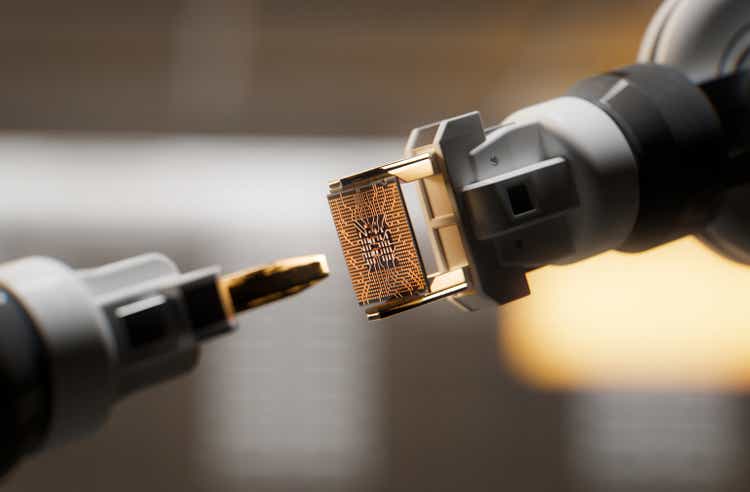
luza studios
Investment firm Barclays weighed in on the semiconductor industry after taking a trip to Asia, including updates on Nvidia’s (NASDAQ:NVDA) Blackwell ramp and potential issues with Apple’s (NASDAQ:AAPL) iPhone.
Regarding Nvidia, analyst Tom O’Malley said utilization for the initial Blackwell ramp is now at roughly 50% and should rise to 80% over the coming quarters.
“Assuming 50% utilization for the existing capacity and traditional lag from test to final sale, this implies NVDA Jan Q Blackwell close to $6B,” O’Malley wrote. Capacity should double to roughly 40,000 wafers per month in April, compared to Hopper, which reached as many as 600,000 units per month in the third-quarter (and expectations of around the same in the fourth quarter), O’Malley added.
Additionally, Blackwell-Ultra solutions are not in the supply chain yet, but should ramp up soon, with the 300 and 300A single die solution, which should leave a “few ramps” coming in the first-half of 2025.
Other AI updates
O’Malley also weighed in on Google’s (GOOG) (GOOGL) TPU v6, which is not expected to come into the supply chain until late in the second-quarter of 2025, with v5 expected to tick down in January and April, “implying a bit of an air pocket before material volume increase in July.”
He said that companies that build application specific integrated circuits are looking to intersect the market at 3 nanometer nodes in 2026, but it’s unlikely that Broadcom (AVGO) and Marvell (MRVL) will lose any share.
Orders for AMD’s (NASDAQ:AMD) MI300 and 325 AI accelerators recently up-ticked for the fourth-quarter, but there is the expected sequential decline in the first-quarter, O’Malley added. He also noted that early signs for AMD’s Xilinx unit appear up double-digits year-over-year, but may be weaker to start the year.
Smartphone issues
The handset market continues to bifurcate, as premium flagship Android devices strength into the end of the year, a fact that bodes well for Qualcomm (NASDAQ:QCOM), O’Malley said.
“This is causing some CQ4 pull-ins likely setting up a bit of a tougher comp into March quarter,” he wrote. “This is also helping QCOM which is having success selling a premium price item at the high end with the new Snapdragon 8 Gen 4 product. QCOM is also stronger in the low-end market, where the supply chain is highlighting more aggressive pricing given the tailwind at the high end.”
Qualcomm should get 100% of the Samsung (OTCPK:SSNLF) Galaxy S25 market, as Samsung’s performance on 3 nanometers won’t allow for an internal ramp, he added.
The mid-tier of the smartphone market “largely doesn’t exist anymore,” which should “structurally impact” Skyworks Solutions (SWKS) and Qorvo (QRVO) for the foreseeable future, O’Malley explained.
Regarding the iPhone, O’Malley said he heard “mixed data points” on cuts, but several sources pointed to a 10% to 15% unit cut in the March quarter as recently as last week. The iPhone SE is also confirmed for a late first-quarter launch with an Apple modem, with 25M or more units expected.
AI PC hype
The AI PC hype from earlier this year appears to be just hype, as there is no “real adoption,” O’Malley said. “AI PCs are only [hundreds of thousands for all of 2025] with ODMs hopeful for more robust uptick with Lunar Lake and Strix Point,” he said, noting that the supply chain talked about a new Qualcomm chip based on Arm (ARM) architecture that could launch in the second-quarter of next year at a $700 price point, compared to roughly $1,500 currently.
Memory mixed
The memory market is mixed, with NAND spending weak and high-bandwidth memory still soaring due to artificial intelligence.
“Conversations with Memory companies are more positive on DRAM but more negative on NAND where demand is expected at mid to high teens in CY25 with supply coming in below that level as PC and Smartphone remain muted,” O’Malley wrote. “NAND technology transitions are a positive for more rational supply, but industry utilization is still structurally off highs. HBM is expected at 60%+ higher than what MU called out with mid $20Bs (capacity suggest close to $40B).”
Capex spending
Capex spending for next year is likely to be “flattish” compared to expectations of growth, with Taiwan Semiconductor (TSM) appearing poised to convert nodes (moving to N3 from N5), while Samsung has had issues with its 3 nanometer yields.
“In aggregate, we see a much more flattish [wafer fab equipment] year in ‘25 than Street estimates today,” O’Malley wrote.
